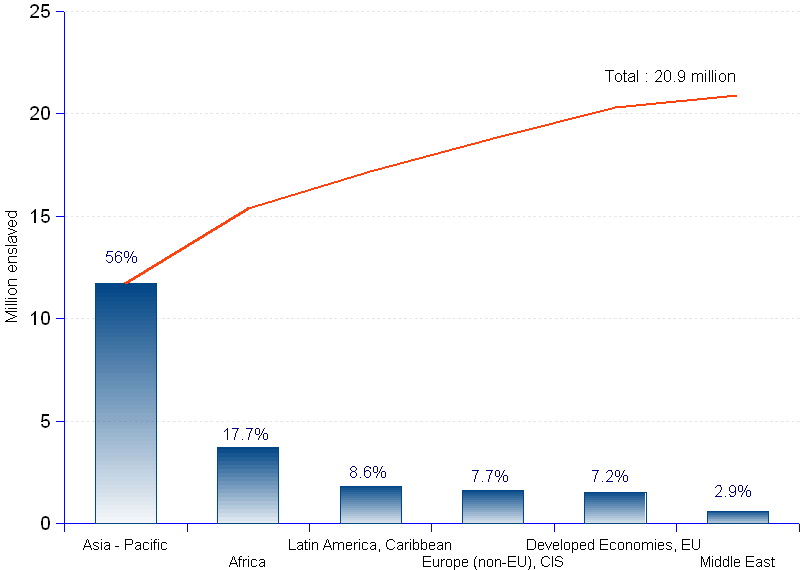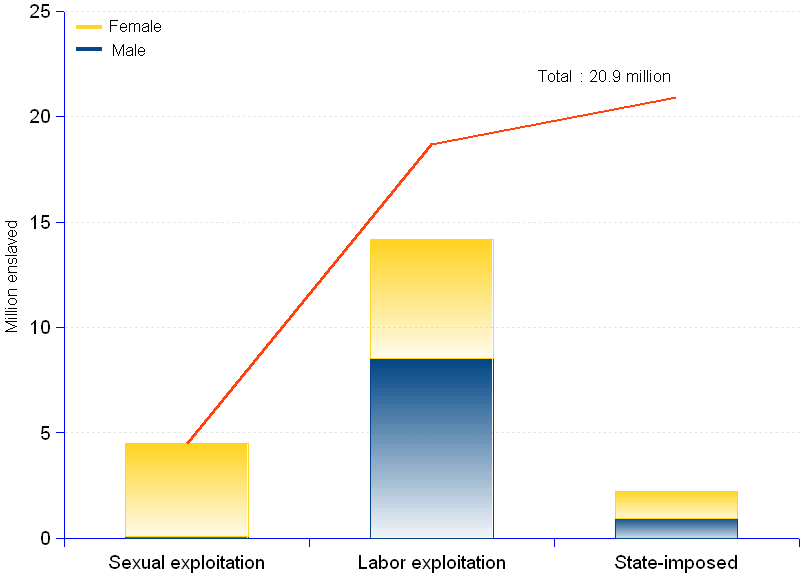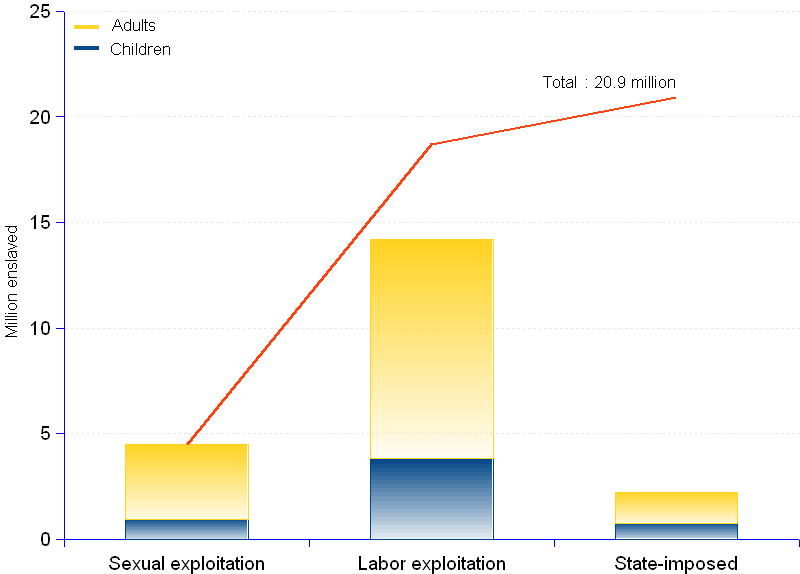![]() Modern-day slavery numbers by : Geographical Region | Gender | Class of Age |
Modern-day slavery numbers by : Geographical Region | Gender | Class of Age |

The International Labor Office (ILO) revised in 2012 their estimates of the global size of "modern-day slavery", placing at 20.9 million the number of people that are currently trapped by deceit or physical coercion into performing jobs in abject conditions of hardship, inhumanity, moral degradation and social abandonment, for a subsistence or below subsistence pay, without the protection of law, without a time limit to their subjection, without any escape window open. The 20.9 million figure is a conservative estimate, given the cautious methodology employed to measure this form of hidden, underground crime.
Slavery is universal, leaving no country exempt, whatever the religious creed or political orientation. The vast Asia-Pacific region accounts for 11.7 million or more than 50% of the world enslaved people. The second highest number is found in Africa at 3.7 million (18%), followed by Latin America and the Caribbean with 1.8 million victims (9%). The Developed Economies and European Union account for 1.5 million (7%), whilst countries of Central, Southeast and Eastern Europe (non EU) and the Commonwealth of Independent States (CIS) have 1.6 million (7%), and the Middle East has 600,000 (3%).
The CIS and Africa regions have the dubious privilege of scoring the highest rates of modern slavery per capita : 4.2 and 4.0 per 1,000 inhabitants respectively. These rates are congruent with the common man perception fed by a multitude of news reports and fiction productions exploring the miseries of trafficking for labor and sexual exploitation and of state-imposed forced labor.
A majority of forced laborers in economic activities, and almost all those in state-imposed forced labor, do not have to move away from their home areas to be trapped into modern-day slavery. In fact, most of them — 11.8 million or 56% — are driven into forced labor in their own place of origin or residence. State-imposed forced labor represents 19% (2.2 million) of that number, the other 81% (9.6 million) being victims of private exploiters. However, a massive number of cases — 9.1 million people or 44% — are associated with migration. Cross-border movement of people is strongly related to forced sexual exploitation. These figures indicate that being in the move can be a high vulnerability factor for certain groups of workers, especially women, the main target of sexual exploitation.
The average period of time that victims spend in forced labor, across all forms and regions, is approximately 18 months, with variation between the different forms of forced labor.
In a time when so many voices publicly demand respect for human rights, and so many tragic wars are waged by the righteous under the banner of human dignity, freedom, women liberation, self-determination, and everyone's right to live a full life, reason fails to explain why there are more slaves now than in all past history.
In 2012 about 21 million people are reduced to the status of cheap, zero-maintenance, disposable tools, without further value other than the immediate profit that can be drawn therefrom. Twenty one million far exceeds what everyone concedes to be a shameful stain of our common past : the 11 million Africans carried across the Atlantic during the 4 centuries of the slave trade, the 14 million victims of 13 century-long intra-African slavery, and the 17 million Africans that fell victim of the Oriental slave trade from 650 to 1920. Slavery today is driven by big profits and cheap lives. It is the business of getting people-tools at the cheapest rates, using them for making fast money, and throwing away the remains. Slavery must be eradicated, because slavery is death. As long as one single slave exists, the enslavement of this person is a permanent threat to the whole of mankind.
ILO estimated number of Modern Slavery Victims | ||
| Region | Million | Percent |
| Asia - Pacific | 11.7 | 56.0% |
| Africa | 3.7 | 17.7% |
| Latin America, Caribbean | 1.8 | 8.6% |
| Europe (non-EU), CIS | 1.6 | 7.7% |
| Developed Economies, EU | 1.5 | 7.2% |
| Middle East | 0.6 | 2.9% |
| Total | 20.9 | 100.0% |


During the Atlantic slave trade, women were the minority, a healthy 15 to 35 years old, 5-feet tall male slave commanding a much higher selling price than a woman slave, despite the ulterior benefits that could be derived from the latter's eventual pregnancy. Women and girls are more affected by today's slavery, and particularly by forced sexual exploitation. They represent the larger share of the total : 11.4 million (55%), as compared to 9.5 million (45%) men and boys. Cross-border movement is closely allied with forced sexual exploitation, whereas a greater proportion of victims of non-sexual forced labour are exploited in their home area.
Of the total 20.9 million enslaved, 18.7 million (90%) are exploited in the private economy, by individuals or enterprises. Out of these, 4.5 million (22%) are victims of forced sexual exploitation, and 14.2 million (68%) are victims of forced labor exploitation in economic activities, such as agriculture, construction, domestic work or manufacturing. The remaining 2.2 million (10%) are in state-imposed forms of forced labor, for example in prisons, or in work imposed by the state military or by rebel armed forces.
ILO estimated number of Modern Slavery Victims | ||||||
Number |
by Gender |
|||||
| Million | Percent | Male | Female | |||
| Million | Percent | Million | Percent | |||
| Private economy (individuals or enterprises), of which : | 18.7 | 89.5% | 8.61 | 90.3% | 10.09 | 88.8% |
| Forced sexual exploitation | 4.5 | 21.5% | 0.09 | 0.9% | 4.41 | 38.8% |
| Forced labor exploitation | 14.2 | 67.9% | 8.52 | 89.4% | 5.68 | 50.0% |
| State-imposed forms of forced labor | 2.2 | 10.5% | 0.924 | 9.7% | 1.276 | 11.2% |
| Total | 20.9 | 9.534 | 100.0% | 11.366 | 100.0% | |


As in the past, today's slavery affects more adults than children : 74% (15.4 million) of victims fall in the age group of 18 years and above, whereas children aged 17 years and below represent 26% of the total (or 5.5 million child victims).
Child labor was a major contributor to the European industrial revolution. Not to mention the illegal use of child labor, a practice that still prevails in some advanced economies today, employers were authorized by law to employ children past age of 9 (England, 1858), or 10 (France 1874, England 1901), or 12 (France 1892, England 1901) for up to 16 hours per day and 60 hours per week, in day or night shifts — although, under the pressure of trade-unions and workers' political activists, the standard work schedule came to be of 10 or 10.5 hours per day, 5.5 or 6 days per week until the 1914 Great War.
But the dreadful precedent has not been discarded : the scourge of child labor still tarnishes our 21st century civilization, in its bleakest form of forced labor.
ILO estimated number of Modern Slavery Victims | ||||||
Number |
by Class of Age |
|||||
| Million | Percent | Children | Adults | |||
| Million | Percent | Million | Percent | |||
| Private economy (individuals or enterprises), of which : | 18.7 | 89.5% | 4.779 | 86.8% | 13.921 | 90.4% |
| Forced sexual exploitation | 4.5 | 21.5% | 0.945 | 17.2% | 3.555 | 23.1% |
| Forced labor exploitation | 14.2 | 67.9% | 3.834 | 69.6% | 10.366 | 67.3% |
| State-imposed forms of forced labor | 2.2 | 10.5% | 0.726 | 13.2% | 1.474 | 9.6% |
| Total | 20.9 | 5.505 | 100.0% | 15.395 | 100.0% | |
[]
Source: ILO - International Labour Organization